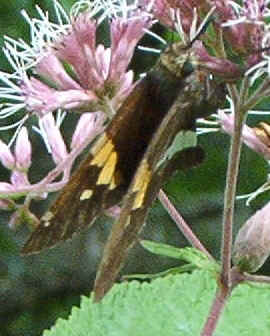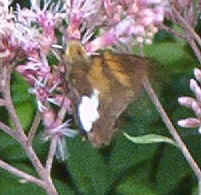 |
 |
Golden-banded Skipper
Scientific Name: Autochton cellus
Family Name: Hesperiidae
 |
 |
1 5/8 - 2 inches. Blackish-brown above with broad, golden-yellow bars across forewings, and a small white spot bar near forewing tip. Hindwing above yellowish near outer angle. Below, forewing similar to upperside with paler grayish or brown near margins; hindwings gray-frosted toward margin with row of submarginal black spots, reddish-brown over disk crossed by 2 hands of dark brown spots without noticeable black outlines. Hindwings fringe checkered on upper 2/3, brown below that to hindwing outer angle. Antennae all black. Similar Species: Hoary Edge has gold above in broken patch, white-frosted below. Gold-spotted Skipper has longer wings, lobed. Life Cycle: Eggs yellow, deposited in rows of 2 - 7, like those of most skippers. Caterpillar chartreuse with yellow stripes and speckles, reddish head; feeds on hog peanut (Amphicarpa) in Maryland and lives in shelter of silk-bound leaves, venturing out to feed at night. Chrysalis dark greenish-brown with waxy bloom; overwinters. Flight: 2 broods in North; May - August. More broods in South; February - September. Habitat: Watersides, woodland ravines, grassy spots. Range: Ohio to New York, south to North Florida, Alabama, Southeast Missouri and Gulf States; also West Texas, Southwest New Mexico, and Southeast Arizona south into Mexico. Information: Many of the big, attractive skippers are limited to the southern states, but this one ranges well into the northeast in small, well-separated colonies. Adults clamber over hollyhocks, bramble blossoms, ironweed, and buttonbush in search of nectar. The smaller False Golden-banded Skipper (Autochton pseudocellus) lacks the yellow on the hind wing costa and grayish scaling below. It is rare in southeastern Arizona. [Pyle, Robert Michael, Audubon Society Field Guide to North American Butterflies, Alfred A. Knopf, New York, 1981]
Butterfly and Moth Home Page * Butterfly and Moth Books * Nature Lovers